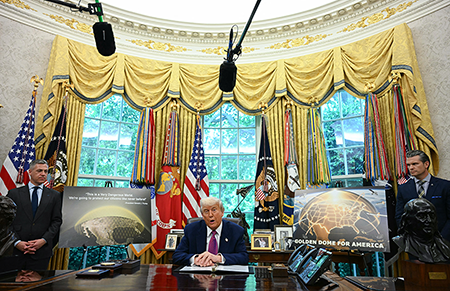Golden Dome: Doubling Down on a Strategic Blunder
June 2025
By Daryl G. Kimball
Nuclear and defense strategists have long understood that the developing and deploying of strategic missile interceptors is ineffective against determined nuclear-armed adversaries because it could lead them to build more numerous and sophisticated offensive missile systems—at a relatively lower cost and more quickly—to overwhelm and evade missile defenses.

Strategic missile defenses can never be effective and reliable enough to defend the entire United States, but they can still negate a portion of a potential missile attack and upset strategic stability. Unless limited by national policy or mutual agreement, as the 1972 Anti-Ballistic Missile (ABM) Treaty once did, ambitious U.S. missile “shield” proposals can spur adversaries such as China and Russia to enhance their strategic forces to maintain the ability to inflict a devastating nuclear retaliatory strike.
Consequently, even after the George W. Bush administration withdrew from the ABM Treaty in 2002 to rush deployment of a limited strategic interceptor program before the next election, U.S. policymakers have focused mostly on improving capabilities to address limited attacks from lesser North Korean missile threats rather than more substantial threats posed by the major nuclear powers.
Upending longstanding U.S. policy and ignoring strategic realities, U.S. President Donald Trump announced May 20 that he wants to spend at least $175 billion of taxpayer dollars for a crash strategic missile interceptor scheme dubbed “Golden Dome” to defend the continental United States against all missile threats, including those from China and Russia, “within three years.” Trump’s radical plan is technically complex, prohibitively expensive, and counterproductive.
Golden Dome, which is still in the conceptual phase, would patch together existing and possibly new ground- and sea-based interceptors and radars with the introduction of hundreds, if not thousands, of space-based sensors and missile interceptors. The system is designed to destroy incoming missiles by destroying them early in flight, targeting them midcourse, or seeking to hit them just before impact on their targets.
Members of Congress from both parties need to cut through Trump’s hyperbole and demand serious answers to basic questions about this initiative before writing a blank check to a few big defense contractors. What specific threat is it designed to defeat? What success rate is being sought? What is the plan for building the system? How will adversaries respond? What effect will it have on strategic stability and space security?
Clearly, Trump’s radical strategic missile defense scheme would be even more costly than advertised. Consider that more than $250 billion already has been allocated to Missile Defense Agency programs since 1985. The Congressional Budget Office recently estimated that a new space-based interceptor program would exceed $500 billion over the next 20 years. That program was originally scoped for the North Korean missile threat of 10 years ago, not today’s threat of the peer and near-peer states that Trump wants to defend against. Even Sen. Tim Sheehy, (R-Mont.), who announced plans to form a Golden Dome caucus, said: “It will likely cost in the trillions if and when Golden Dome is completed.”
No matter how much money is spent on exotic crash programs, however, an effective U.S. missile defense system will not be feasible anytime soon, which means that it will not affect strategic stability in the near term. As a result, Chinese and Russian military planners would be smart not to overreact by building up their strategic offensive nuclear forces.
If Trump’s strategic missile defense plan is eventually implemented, however, it would destabilize the already precarious nuclear balance of terror that exists among the major nuclear-armed powers. It would heighten the danger that space will become a war zone and push China and Russia to further improve and expand their strategic offensive capabilities.
Moscow is already developing new systems—such as an undersea torpedo, a hypersonic glide vehicle, and a nuclear-powered cruise missile—to ensure it can overcome any future U.S. missile defenses. It is also developing a capability for a nuclear-armed anti-satellite weapon, which underscores the vulnerabilities of a space-based interceptor network. Beijing, meanwhile, has already begun to respond to U.S. missile defense and conventional long-range strike capabilities by increasing its nuclear-armed ballistic missile force.
These factors make it even more vital that Russia and the United States engage immediately in strategic stability talks and negotiations to cap or reduce their massive strategic nuclear arsenals before the last remaining treaty, the New Strategic Arms Reduction Treaty, expires in 2026. China, too, needs to back up its complaints about U.S. unilateralism, strategic missile defense, and space-based interceptors by agreeing to participate in direct, high-level, strategic risk-reduction talks with the United States.
If Trump, Russian strongman Vladimir Putin, and Chinese dictator Xi Jinping continue to bicker in public rather than negotiate mutually beneficial limits on strategic offensive and defensive weapons, the world faces a more dangerous future.
